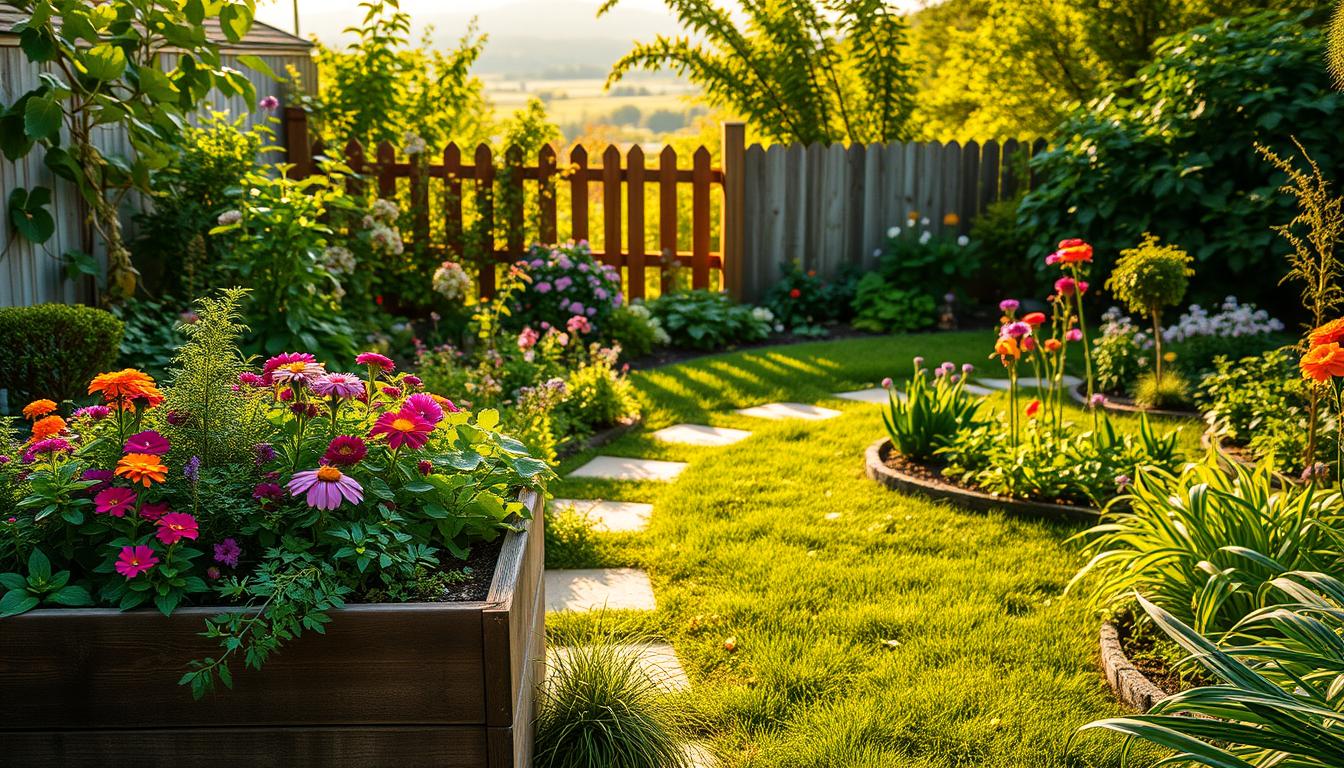Transforming your outdoor area into a vibrant, green haven is easier than you think. With the right design, you can create a space that’s both beautiful and functional. Raised beds, for example, offer improved soil control and make gardening more accessible for everyone.
Whether you’re working with a compact area or a sprawling landscape, there’s a solution for you. From sleek, modern designs to rustic, natural setups, the possibilities are endless. These ideas are also seasonally adaptable, ensuring your space thrives year-round.
In this guide, we’ll explore 15 creative ideas to inspire your next project. You’ll find practical tips and design inspiration to help you craft the perfect outdoor retreat. Let’s get started!
Key Takeaways
- Raised beds improve soil quality and accessibility.
- Creative designs work for both small and large spaces.
- Seasonal adaptability ensures year-round beauty.
- Practical tips make gardening easier and more enjoyable.
- Inspiration for modern and rustic styles.
Introduction to Backyard Garden Beds
Garden beds are the foundation of a thriving and organized outdoor space. These defined planting areas allow you to grow a variety of plants and vegetables with ease. Whether you choose in-ground or raised beds, they provide structure and efficiency to your gardening efforts.
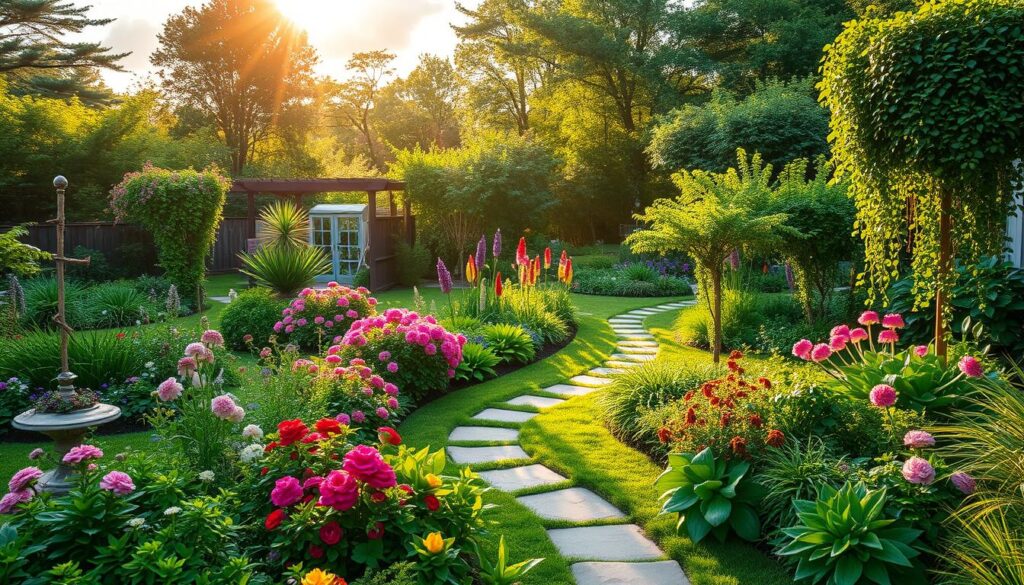
What is a Garden Bed?
A garden bed is a designated area for growing plants, often bordered by materials like wood, stone, or metal. Raised beds elevate plants above ground level, offering better soil control and drainage. This modern solution contrasts with traditional in-ground gardening, which can lead to soil compaction over time.
Benefits of Creating a Garden Bed
Raised beds come with numerous advantages. They reduce weeds, improve drainage, and make gardening more accessible, especially for elderly individuals. Studies show that raised beds can increase vegetable yields by up to 30%, making them a practical choice for home gardeners.
| Feature | Traditional In-Ground | Raised Bed |
|---|---|---|
| Soil Control | Limited | High |
| Weed Reduction | Moderate | Significant |
| Accessibility | Low | High |
| Yield Potential | Standard | Up to 30% Higher |
Planning Your Backyard Garden Bed
Planning your outdoor space starts with understanding its unique needs. A well-prepared layout ensures your plants thrive and your design remains functional. Whether you’re working with a small corner or a larger area, careful preparation is essential.
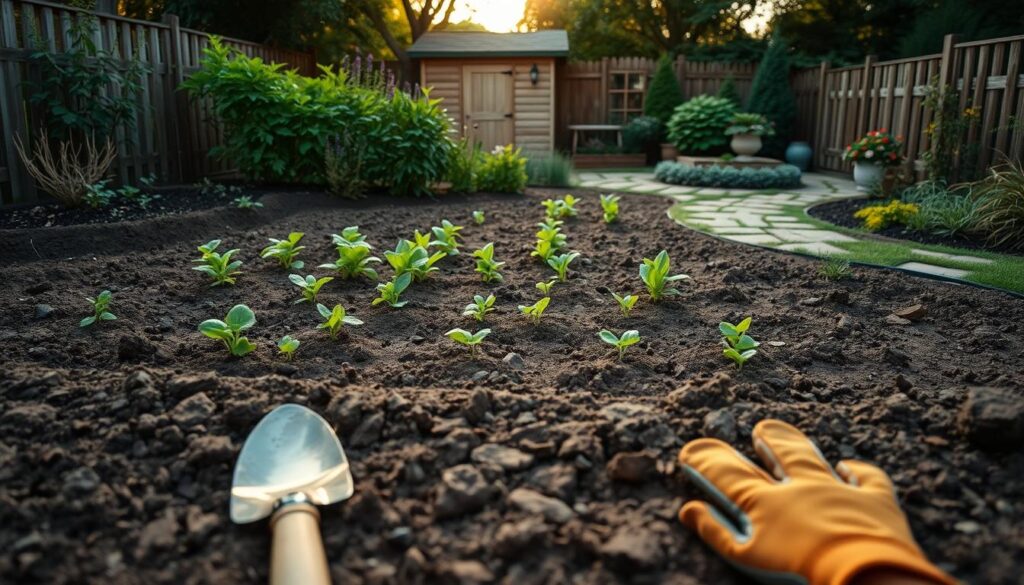
Choosing the Right Location
Start by evaluating your space. Look for a spot that receives at least six hours of sunlight daily, especially if you’re growing vegetables. Use sun mapping techniques to track how light moves across your area throughout the day.
Consider microclimate factors like wind patterns and frost pockets. These can affect plant health and growth. A sheltered spot can protect delicate plants from harsh weather.
Assessing Sunlight and Soil Conditions
Test your ground for soil compaction using a spading fork. Compacted soil can hinder root growth and water drainage. Perform a percolation test to check how well water moves through the soil.
Invest in a soil pH testing kit, which typically costs between $15 and $30. Most plants prefer a pH level between 6.0 and 7.0. Adjusting your soil’s pH can significantly improve plant health.
For more tips on starting your project, check out this beginner’s guide to gardening.
Designing Your Backyard Garden Bed
Crafting a stunning outdoor space starts with thoughtful design choices. The right layout can enhance both functionality and beauty, making your area a joy to use. Whether you prefer a rustic charm or a sleek modern look, the possibilities are endless.
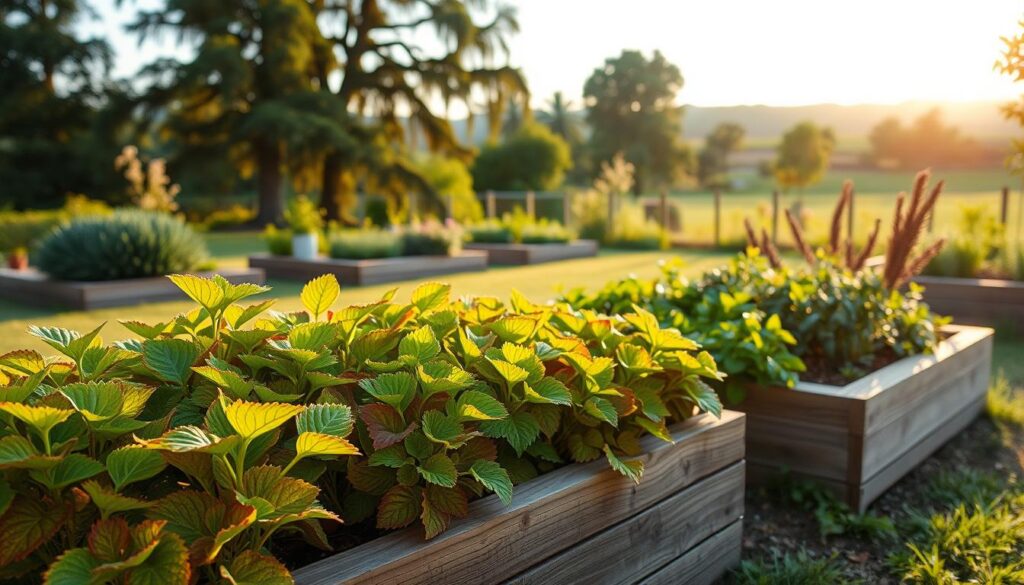
Traditional vs. Modern Garden Bed Designs
Traditional designs often feature natural materials like cedar, which offers natural rot resistance. These rustic styles blend seamlessly with nature, creating a timeless appeal. On the other hand, modern designs lean toward materials like galvanized steel, which provides a sleek and contemporary aesthetic.
For example, corten steel designs are durable and visually striking, perfect for a minimalist design. Both styles have their unique advantages, so choose based on your personal preference and the overall theme of your space.
Incorporating Pathways and Borders
Pathways and borders are essential for both accessibility and aesthetics. For wheelchair access, aim for pathway widths between 18″ and 24″. Curved borders not only add visual interest but can also increase planting space by up to 15%.
When planning drainage, ensure a slope of 1/4″ per foot to prevent waterlogging. Warm tones in borders can enhance the appeal of edible gardens, making them both functional and inviting. With these tips, your outdoor area will be both beautiful and practical.
Types of Backyard Garden Beds
Exploring different types of planting areas can elevate your outdoor experience. Each option offers unique benefits, whether you’re growing vegetables, herbs, or flowers. Let’s dive into the three main styles to help you choose the best fit for your space.
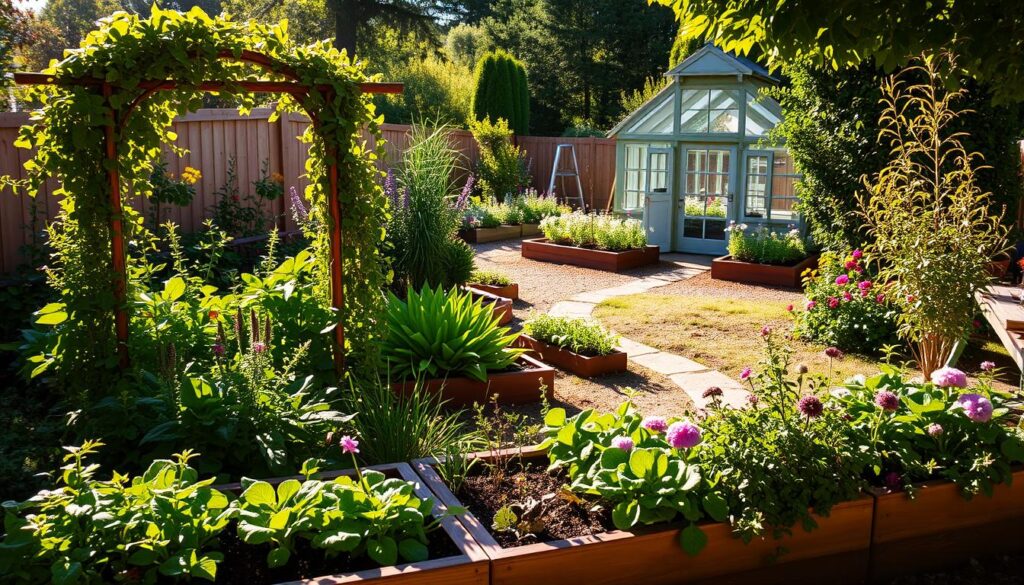
Raised Garden Beds
Raised garden beds are a popular choice for their versatility and ease of use. They allow for better soil control and drainage, making them ideal for vegetables like tomatoes, which need at least 12 inches of root depth. A standard 4×8-foot size is perfect for most home setups.
Costs vary widely, from $50 for a DIY wood frame to $300 for premium composite materials. This flexibility makes them a great option for gardeners of all budgets. Popular plants for raised beds include peppers, carrots, and leafy greens.
In-Ground Garden Beds
In-ground beds leverage the natural soil and earthworms, creating a sustainable planting environment. They’re cost-effective since they require minimal materials. However, they may need more preparation, like soil testing and amendments.
These beds are excellent for plants with shallow roots, such as lettuce, which thrives in just 6 inches of soil. Other great choices include beans, peas, and herbs like basil. Their seamless integration with the ground makes them a natural fit for larger spaces.
Container Garden Beds
Container beds are perfect for patios or small areas. They’re portable, easy to maintain, and can be customized with creative irrigation hacks, like using wine barrels. This makes them a practical choice for urban gardeners.
Plants like strawberries, dwarf tomatoes, and herbs flourish in containers. Their compact size and adaptability make them a versatile option for any outdoor space. Plus, they’re ideal for renters or those who want to experiment with different layouts.
- Raised Beds: Great for soil control, ideal for deep-rooted plants like tomatoes.
- In-Ground Beds: Cost-effective, best for shallow-rooted plants like lettuce.
- Container Beds: Portable and perfect for patios, great for herbs and small vegetables.
Materials for Building Garden Beds
Choosing the right materials for your planting area can make a big difference in its longevity and performance. From durable wood to sleek metal and eco-friendly options, each choice has unique benefits. Let’s explore the best options to help you create a functional and stylish space.
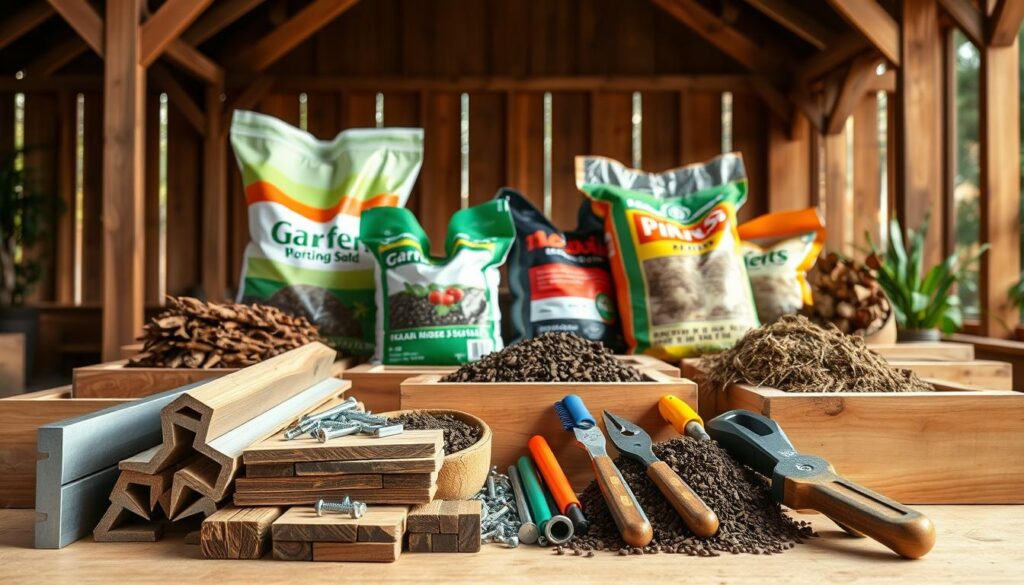
Wood Options: Cedar, Redwood, and Pine
Wood is a classic choice for building raised planting areas. Cedar and redwood are naturally rot-resistant, making them ideal for long-term use. Cedar raised beds can last 10-15 years, while pine, though more affordable, typically lasts only 3-5 years.
ACQ-treated wood is a safe option for edibles, ensuring your plants remain healthy. For a rustic look, consider using cedar boards, which add charm and durability to your setup.
Metal and Composite Materials
Metal beds, especially those made from galvanized steel, are gaining popularity for their modern appeal. A 16-20 gauge steel frame is recommended for durability. Metal beds also warm the soil faster, which can benefit early-season planting.
Composite materials, like recycled HDPE, offer a sustainable alternative. These materials can last over 20 years and are resistant to weather damage. They’re a great choice for those looking for low-maintenance options.
Eco-Friendly Recycled Plastic Beds
Recycled plastic beds are an excellent eco-conscious choice. USDA-approved brands use high-density polyethylene (HDPE), which is durable and long-lasting. These beds are lightweight, easy to assemble, and resistant to pests and rot.
Cost comparisons show that recycled plastic beds are competitively priced, making them an affordable and sustainable option for any outdoor project.
- Wood: Cedar and redwood are durable, while pine is budget-friendly but less long-lasting.
- Metal: Galvanized steel beds warm soil quickly and offer a sleek, modern look.
- Recycled Plastic: Eco-friendly, durable, and low-maintenance, with a lifespan of 20+ years.
Step-by-Step Guide to Building a Raised Garden Bed
Building a raised planting area is a rewarding project that combines creativity and practicality. With the right tools and materials, you can create a sturdy and functional space for your plants. Let’s walk through the process step by step.
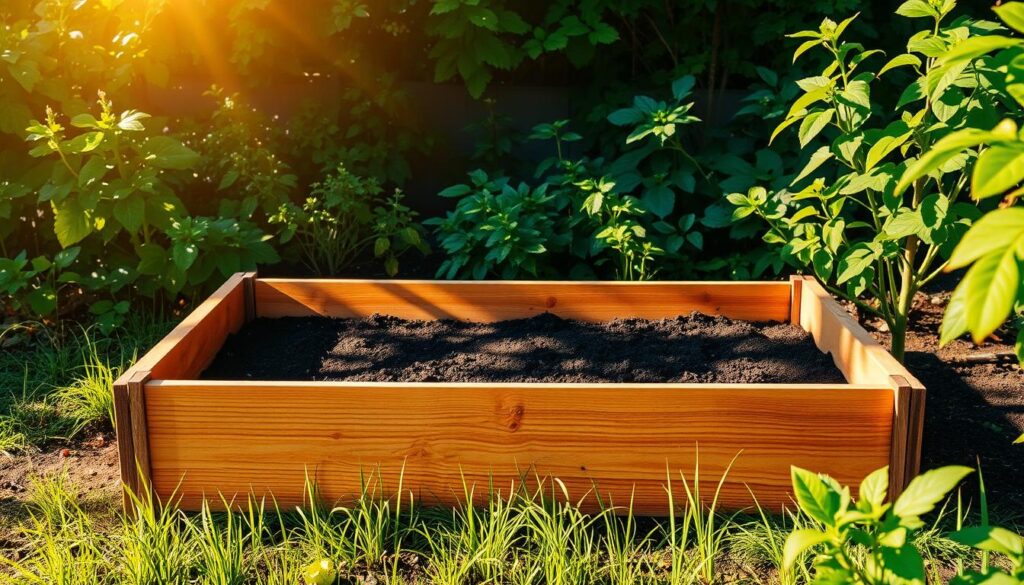
Tools and Materials Needed
To get started, you’ll need a few essential tools and materials. A compound miter saw will help you make precise cuts, while deck screws ensure a secure assembly. For a standard 4×6-foot frame, you’ll require 2×4 boards and 10½” posts for stability.
- Compound miter saw
- Deck screws
- 2×4 boards
- 10½” posts
- Hardware cloth (to deter pests)
Constructing the Frame
Start by cutting your boards to the desired length. For a 4×6-foot frame, you’ll need two 6-foot boards and two 4-foot boards. Use half-lap or butt joints to connect the corners securely. Attach the hardware cloth to the bottom to prevent gophers and other pests from entering.
Once the frame is assembled, place it in your chosen location. Ensure it’s level and stable before moving on to the next step.
Filling the Bed with Soil
Fill your raised planting area with a balanced soil mix. A good strategy is to use 60% topsoil, 30% compost, and 10% perlite for optimal drainage and nutrients. Calculate the soil volume using the formula: Length x Width x Height / 27.
Layer the soil evenly, ensuring it’s packed firmly but not compacted. This will provide a healthy environment for your plants to thrive.
Choosing the Right Soil for Your Garden Bed
Healthy soil is the cornerstone of any successful outdoor project. The right mix ensures your plants thrive, whether you’re growing vegetables, herbs, or flowers. A nutrient-rich soil blend provides the essential elements plants need to grow strong and healthy.
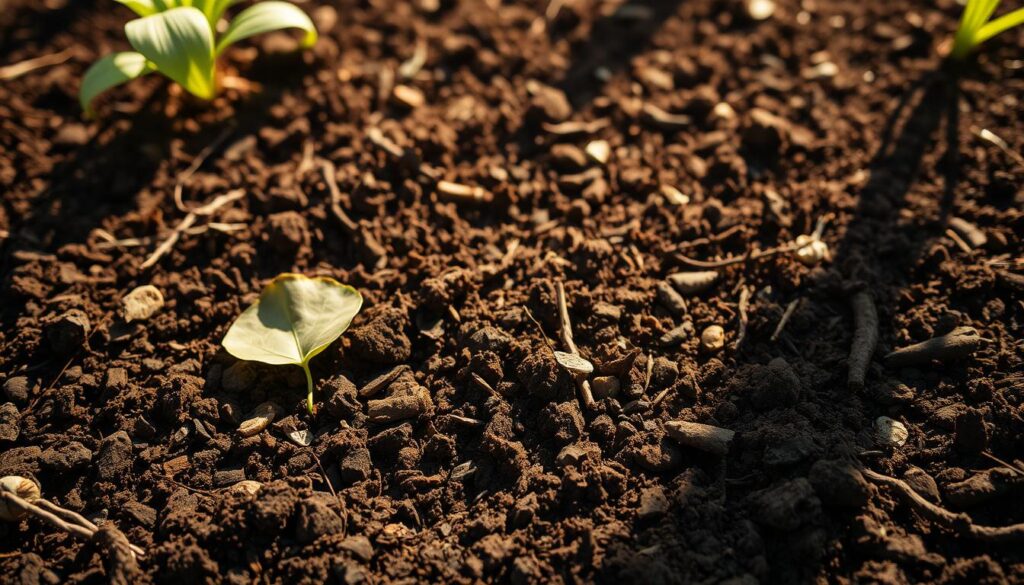
Nutrient-Rich Soil Mixes
Commercial soil mixes like Miracle-Gro and FoxFarm are popular choices for their balanced formulas. Miracle-Gro is known for its quick-release nutrients, while FoxFarm offers organic options with added microbes. Both are excellent for fill raised planting areas, but it’s essential to check the ingredients for peat-heavy mixes, which can become hydrophobic over time.
For a DIY approach, aim for a 3:1 ratio of soil to compost. This blend ensures proper drainage and nutrient availability. Adding organic amendments like worm castings or biochar can further enhance soil health by improving its cation exchange capacity (CEC).
Adding Compost and Organic Matter
Compost is a game-changer for any planting project. It enriches the soil with nutrients and improves its structure. Brewing compost tea is a cost-effective way to add beneficial microbes to your mix. Simply steep compost in water for 24-48 hours, then apply it to your soil.
Avoid chemical-treated topsoils, as they can harm beneficial organisms. Instead, focus on organic matter like leaf mold or aged manure. These natural amendments create a fertile environment for plants to flourish.
“Healthy soil is alive with microorganisms that support plant growth. Investing in quality soil pays off in the long run.”
- Commercial Mixes: Miracle-Gro for quick nutrients, FoxFarm for organic options.
- DIY Mix: Use a 3:1 soil-to-compost ratio for balanced nutrition.
- Organic Amendments: Worm castings, biochar, and compost tea boost soil health.
- Avoid: Chemical-treated topsoils and peat-heavy mixes.
Planting in Your Backyard Garden Bed
Choosing the right plants and arranging them properly can make your outdoor space thrive. Whether you’re growing vegetables, herbs, or flowers, thoughtful planning ensures a healthy and productive area. Let’s explore how to select the best options and arrange them for optimal growth.

Selecting the Right Plants
Start by considering your climate and the amount of sunlight your space receives. Some plants thrive in full sun, while others prefer partial shade. For a raised bed garden, vegetables like tomatoes, peppers, and leafy greens are excellent choices. Herbs such as basil and parsley also grow well in these setups.
Staggering planting dates can provide a continuous harvest throughout the season. For example, plant lettuce every two weeks to ensure a steady supply. When transplanting, gently break the root balls to encourage better root growth and nutrient absorption.
Spacing and Arrangement Tips
Proper spacing is crucial for healthy growth. Overcrowding can lead to competition for nutrients and increased susceptibility to diseases. Use a companion planting chart to pair plants that benefit each other. For instance, tomatoes and basil grow well together, as basil repels pests that target tomatoes.
Here’s a quick guide to companion planting:
| Plant | Companion | Benefit |
|---|---|---|
| Tomatoes | Basil | Pest repellent |
| Carrots | Onions | Pest deterrent |
| Beans | Corn | Natural support |
Consider intensive planting for small spaces, where plants are placed closer together to maximize yield. Alternatively, square foot gardening divides the area into sections for better organization. Pollinator-attracting flowers like marigolds and zinnias can also enhance your space by attracting beneficial insects.
Watering and Maintenance Tips
Keeping your plants healthy requires smart watering and regular maintenance. With the right techniques, you can save time and ensure your space thrives. Let’s explore some practical tips to make this process easier.
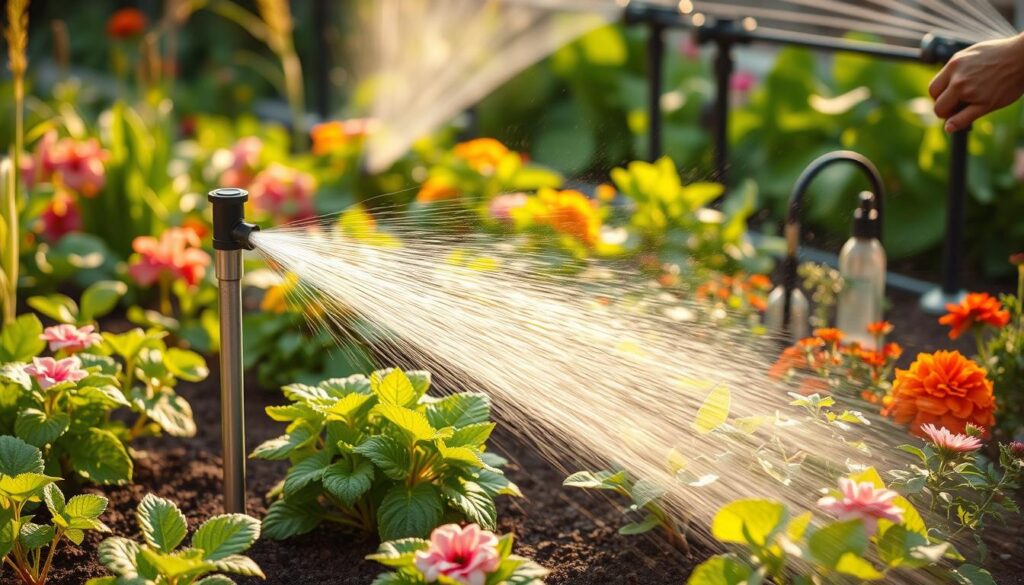
Efficient Watering Techniques
Using soaker hoses can reduce evaporation by up to 50%, making them a great choice for conserving water. These hoses deliver moisture directly to the roots, ensuring plants get what they need without waste.
Morning watering is another effective strategy. It prevents mildew by allowing leaves to dry during the day. For larger areas, consider installing a drip irrigation system. This method provides consistent moisture while minimizing effort.
Weed Control and Soil Care
Mulching is a simple way to suppress weed growth and retain soil moisture. Aim for a depth of 2-3 inches for optimal results. Organic options like corn gluten meal can also help keep weeds at bay naturally.
Regular soil testing every 2-3 years ensures your plants get the nutrients they need. Adding compost or organic matter improves soil structure and fertility. Seasonal preparation, like clearing debris and refreshing mulch, keeps your space in top shape year-round.
- Install a drip irrigation system for consistent watering.
- Mulch to a depth of 2-3 inches to suppress weeds.
- Use organic weed suppressants like corn gluten meal.
- Test soil every 2-3 years for nutrient balance.
- Follow a seasonal checklist for ongoing maintenance.
Backyard Garden Bed Layout Ideas
Designing an efficient layout for your outdoor area can transform its functionality and beauty. Whether you’re working with a small corner or a larger space, thoughtful planning ensures every inch is used effectively. From vertical gardening to eye-catching flower beds, these ideas will help you create a space that’s both practical and stunning.
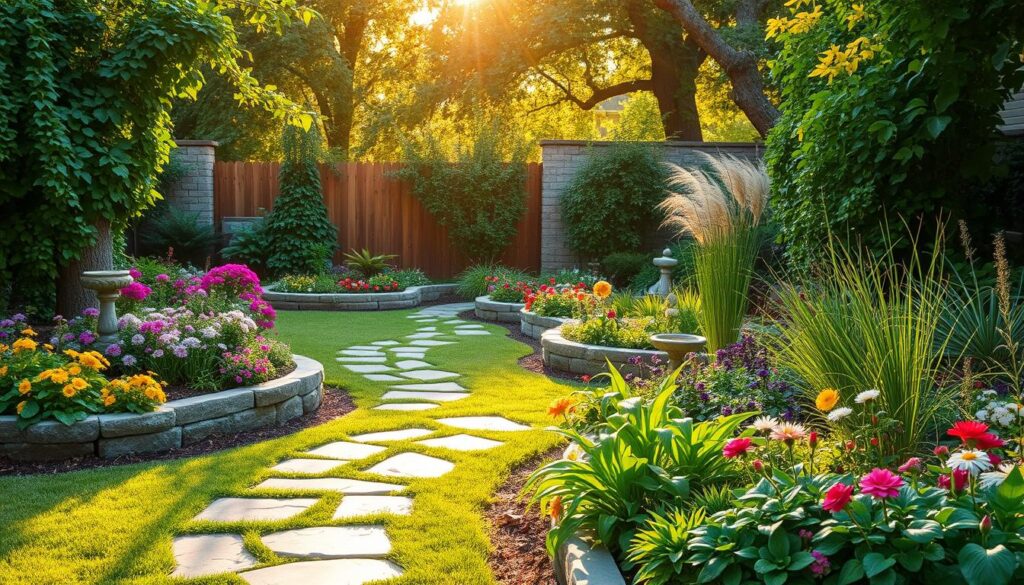
Maximizing Space with Vertical Gardening
Vertical gardening is a smart way to make the most of limited space. Trellises, cattle panel arches, and espalier fruit trees are excellent tools for growing upwards. For example, a cattle panel arch can support climbing plants like beans or cucumbers, adding both function and charm to your design.
Here’s a quick guide to building a cattle panel arch:
- Choose a sturdy cattle panel and bend it into an arch shape.
- Secure the ends into the ground using rebar or stakes.
- Plant climbing vegetables or flowers at the base for vertical growth.
Creating a Focal Point with Flower Beds
Flower beds can serve as the centerpiece of your outdoor area. English-style designs, with their mix of colors and textures, are a popular choice. Consider color-blocking strategies to create visual impact. For instance, grouping white blooms like moonflowers and daisies can create a serene look.
Here are some edible flower varieties to incorporate:
| Flower | Benefits |
|---|---|
| Nasturtiums | Adds peppery flavor to salads |
| Calendula | Edible petals with anti-inflammatory properties |
| Lavender | Adds a floral note to desserts |
By combining vertical gardening with striking flower beds, you can create a layout that’s both functional and beautiful. These ideas ensure your outdoor area is a joy to use and admire.
Seasonal Planting in Garden Beds
Seasonal planting keeps your outdoor space vibrant and productive year-round. By aligning your planting schedule with the seasons, you can maximize yield and ensure healthy growth. Whether you’re growing vegetables, herbs, or flowers, understanding the right time to plant is key.
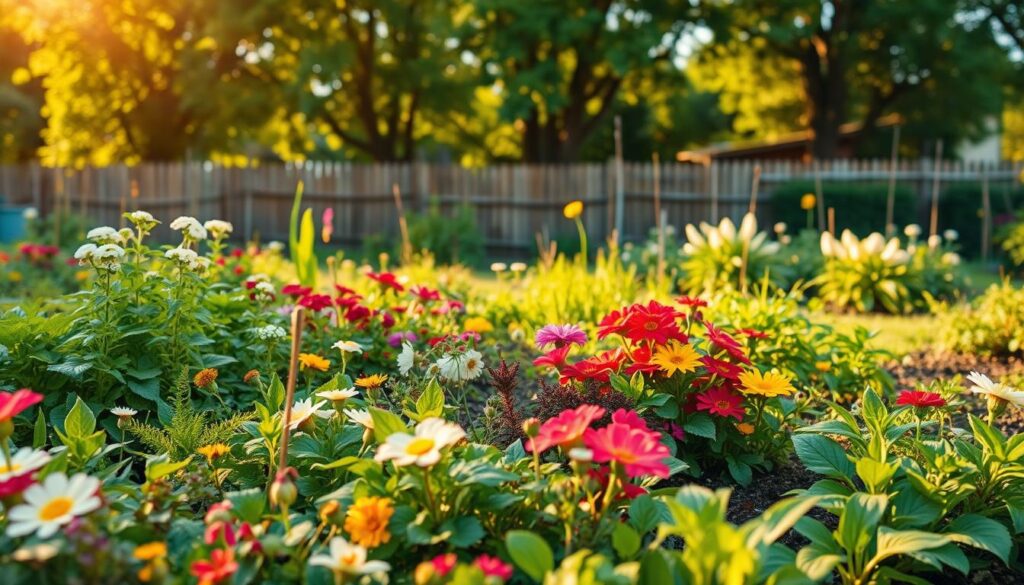
Spring and Summer Crops
Spring and summer are ideal for warm-season plants like tomatoes, peppers, and cucumbers. These crops thrive in full sunlight and well-drained soil. Start by checking your USDA zone-specific planting calendar to determine the best planting dates.
For a continuous harvest, consider succession planting. This involves staggering planting dates every two weeks. Heat-tolerant tomato varieties, such as ‘Solar Fire’ or ‘Heatmaster,’ are excellent choices for summer. Pair them with basil or marigolds to naturally repel pests.
Fall and Winter Planting Tips
Cool-season crops like kale, spinach, and garlic are perfect for fall and winter. These plants can withstand lower temperatures and even light frosts. Use cold frames, cloches, or row covers to protect them from harsh weather.
Overwintering garlic and onions is a great way to extend your harvest. Plant them in late fall, and they’ll be ready by early spring. For added protection, mulch your raised bed with straw or leaves to insulate the soil.
- Check USDA zone-specific planting calendars for accurate timing.
- Use frost protection methods like cloches or row covers.
- Overwinter garlic and onions for an early spring harvest.
- Choose heat-tolerant tomato varieties for summer planting.
- Follow a succession planting schedule for continuous yields.
Accessorizing Your Garden Bed
Enhancing your planting area with thoughtful accessories can elevate both its functionality and beauty. From trellises to decorative touches, these additions bring personality and purpose to your space. Whether you’re aiming for a rustic charm or a modern look, the right accessories can make all the difference.
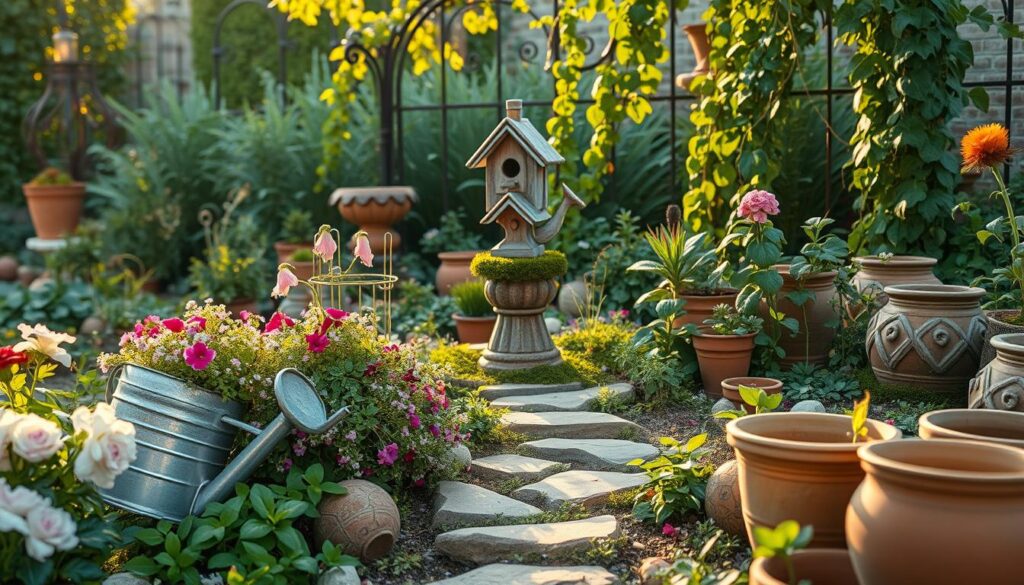
Adding Trellises and Supports
Trellises and supports are essential for climbing plants like beans, cucumbers, and tomatoes. Bamboo trellises offer a natural design, while powder-coated steel provides durability and a sleek appearance. Both options are weather-resistant and easy to install.
For a DIY project, consider creating an obelisk using copper pipe. This stylish support not only adds height but also becomes a focal point in your raised garden. Pair it with climbing flowers like morning glories for a stunning visual effect.
Incorporating Decorative Elements
Decorative elements can transform your space into a cohesive and inviting area. Solar-powered LED lighting is a practical and eco-friendly choice, illuminating pathways and highlighting key features. Hand-painted markers add a personal touch, making it easy to identify your plant varieties.
For a unique twist, try decorative mulch options like glass or stone. These materials not only suppress weeds but also add a pop of color to your garden beds. Wind chimes, strategically placed, can deter pests while creating a soothing ambiance.
“Accessories are the finishing touch that turns a functional space into a work of art.”
- Bamboo or powder-coated steel trellises for climbing plants.
- DIY obelisk plans using copper pipe for added height.
- Solar-powered LED lighting for eco-friendly illumination.
- Hand-painted markers for a personalized touch.
- Decorative mulch options like glass or stone for added color.
Backyard Garden Bed Ideas for Small Spaces
Even the tiniest corners can become thriving green spaces with the right approach. Whether you’re working with a balcony, patio, or a compact yard, there are plenty of ways to maximize your space and create a lush, productive area. From compact raised beds to innovative container setups, these ideas will help you make the most of your limited area.
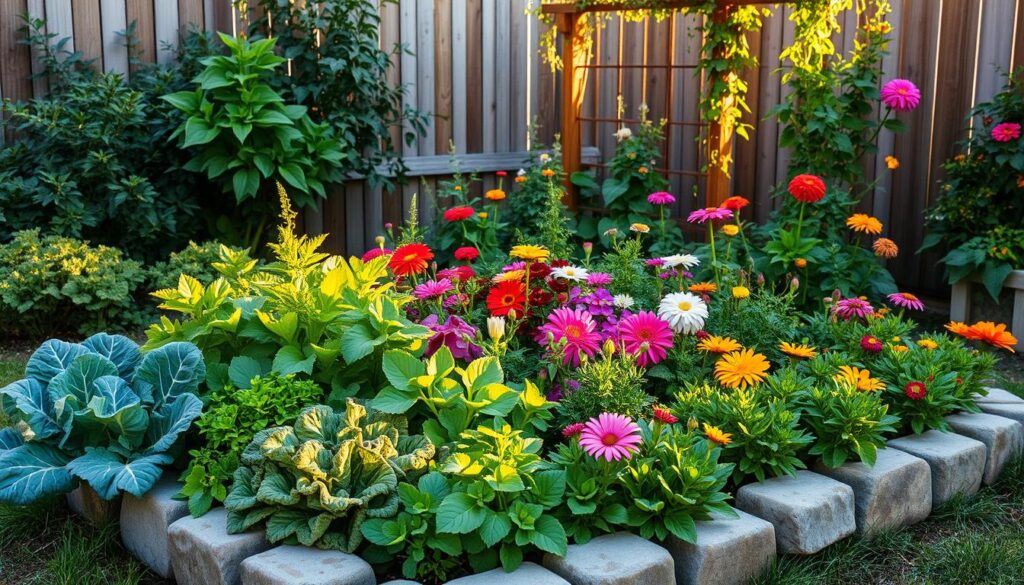
Compact Raised Beds
For small areas, compact raised beds are a game-changer. A 24″x24″ cedar kit is perfect for balconies or patios, offering durability and a natural look. These kits are easy to assemble and provide excellent soil control, making them ideal for growing herbs, vegetables, or flowers.
Consider tiered plant stands to add vertical layers to your setup. This not only saves space but also creates a visually appealing arrangement. Foldable trellis systems are another great option, allowing you to support climbing plants without taking up too much room.
Container Gardening Solutions
Container gardening is a versatile solution for small spaces. Fabric pots are lightweight, portable, and provide excellent drainage, making them a practical choice. Use them to grow herbs, strawberries, or even dwarf tomatoes.
Hanging gutter gardens are a creative way to utilize vertical space. They’re perfect for growing herbs or small vegetables like lettuce. For a unique touch, try spiral herb beds, which combine functionality with a striking design.
- Window box herb gardens add charm to any space.
- Tiered plant stands maximize vertical growing areas.
- Hanging gutter gardens are perfect for small vegetables.
- Foldable trellis systems support climbing plants.
- Spiral herb beds combine beauty and practicality.
Backyard Garden Bed Ideas for Large Spaces
Large outdoor spaces offer endless possibilities for creating a lush and functional green area. With plenty of room, you can design a layout that’s both beautiful and highly productive. Whether you’re growing vegetables, herbs, or flowers, thoughtful planning ensures every inch is used effectively.
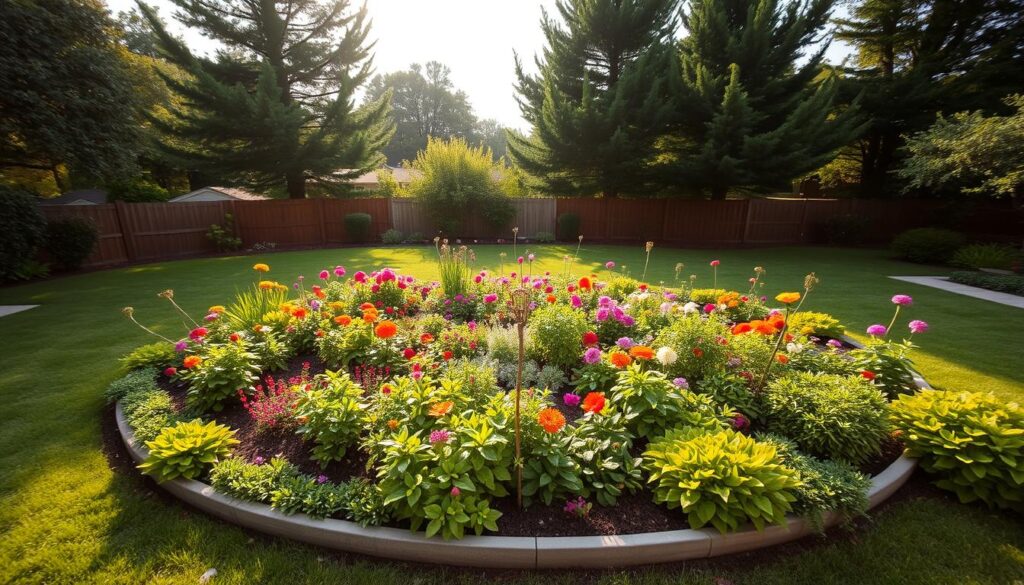
Expansive Raised Beds
Expansive raised beds are perfect for large areas. They provide excellent soil control and make gardening more accessible. A series of raised beds can be arranged in a grid or circular pattern, creating a visually appealing design.
For example, a 4×8-foot raised bed is ideal for growing vegetables like tomatoes and peppers. Pairing them with herbs like basil or parsley adds both functionality and beauty. These beds can also be customized with trellises for climbing plants, maximizing vertical space.
Creating a Garden Bed Network
A network of planting areas can transform a large space into a cohesive and productive area. Connect beds with pathways made of gravel or stepping stones for easy access. This setup not only enhances functionality but also adds a structured look to your outdoor space.
Consider incorporating a mix of raised and in-ground beds for variety. Use borders to define each area and add decorative elements like solar-powered lights or hand-painted markers. This approach ensures your space is both practical and visually stunning.
- Arrange raised beds in grids or circles for a structured layout.
- Use pathways to connect beds and improve accessibility.
- Mix raised and in-ground beds for variety and visual interest.
- Add decorative elements like lights or markers for a personal touch.
Backyard Garden Bed Ideas for Edible Gardens
Growing your own food can be both rewarding and sustainable with the right setup. An edible garden not only provides fresh produce but also connects you with nature. Whether you’re planting vegetables, herbs, or fruit trees, thoughtful planning ensures a bountiful harvest.
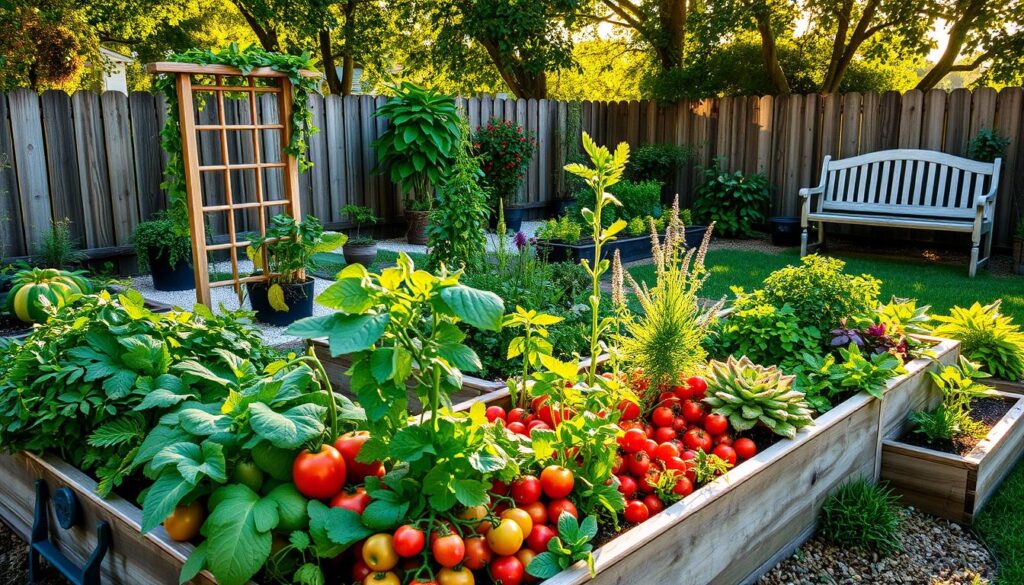
Vegetable and Herb Garden Beds
Vegetable and herb beds are the foundation of any edible garden. Start by choosing a sunny spot with well-drained soil. Popular choices like tomatoes, peppers, and basil thrive in raised beds, which offer better soil control and drainage.
For a continuous harvest, stagger planting dates every two weeks. Companion planting can also enhance growth—pair tomatoes with basil to naturally repel pests. Use organic mulch to retain moisture and suppress weeds, ensuring your plants stay healthy.
Fruit Trees and Berry Bushes
Fruit trees and berry bushes add variety and sweetness to your outdoor space. Dwarf varieties of apple or cherry trees are perfect for smaller areas, while blueberries and raspberries thrive in acidic soil. Plant them in well-spaced rows or clusters for easy access and maintenance.
Consider adding trellises for climbing berries like blackberries. This not only saves space but also creates a visually appealing setup. With proper care, these plants can provide fresh fruit for years to come.
Conclusion: Transform Your Backyard with Garden Beds
Creating a thriving green space with raised beds and edible plants is both fulfilling and sustainable. Whether you’re growing vegetables, herbs, or fruit trees, thoughtful planning ensures a bountiful harvest. Incorporating permaculture concepts, like a food forest, can enhance biodiversity and productivity.
For smaller spaces, consider berry bushes with trellis systems, perfect for blackberries or raspberries. Integrating pollinator hotels supports beneficial insects, boosting your edible garden’s health. Heirloom vegetable preservation adds variety and connects you to traditional gardening practices.
Over five years, the cost-benefit analysis shows significant savings and environmental impact. With the right setup, your space becomes a sustainable haven, providing fresh produce and a deeper connection to nature.

